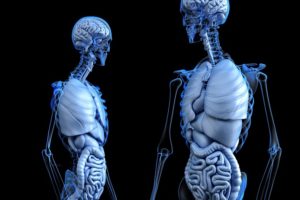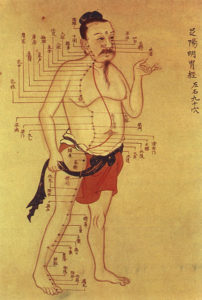
A little while ago in one of the videos on the Qi Life Youtube Channel, I discussed some of the mechanics of how the movement in a particular exercise was used to stimulate energy flow. A viewer asked a question along the lines of: “If this gentle movement stimulates the energy effectively, wouldn’t the vigorous movement in another type of ‘normal’ exercise stimulate the energy even more, and thus be even more beneficial?” I think it is a fair question to ask, so this article is partially in response to that question, but I also hope that I cover some interesting points that will help all readers to appreciate the unique benefits of qigong and its relationship to other kinds of exercise.
So, here are ten ways that qigong is different from normal exercise:
1. Qigong Focuses on Energy
I will start with the most fundamental difference between qigong and other types of exercise. It is implicit in the word itself: Qi means energy, and Gong means work or skill, so qigong means to work with energy and develop skill with it. There are many, many different types of qigong exercise that have many different characteristics, but by definition, this is the thing that unites them all – their focus on energy. This is important, because what we focus on determines to a large extent how our resources are deployed and what the effect will be. In fact there are some qigong practices that are very similar to other more ‘normal’ types of exercise, such as qigong walking, where the experience and results achieved from the same activity, are very different due to the focus on the energy while performing that activity.
Becoming aware of and developing skill with your energy can be a very fulfilling and worthwhile experience in and of itself, and it also leads to many of the other benefits we will talk about as we continue with this article.
2. Qigong Is A Kind of Moving Meditation
Qigong requires a state of relaxed focus and awareness. This is a pre-requisite for us to tune into and start to work with and direct our energy. So qigong exercises inherently work with both the mind and body together. Qigong practice naturally mental focus, and clarity in much the same way as other meditative practices do, but because the mental focus is combined with movement, many people find it much easier to enter a state of stillness and peace by doing qigong than in sitting meditation. In this way qigong is truly a kind of moving meditation, with the same benefits as other types of meditation, but in a form that is more easily accessible for many people.
3. Innercise vs Exercise
‘Normal’ kinds of exercise tend to focus on the external body – the activity of the muscles. Because of the way Qigong combines the mind and body, it can also be a type of innercise – focusing on some of the more subtle things inside us, and not just the outside. I should note here that it does not have to be either or. Just because qigong may be focused on things inside, does not mean that it won’t also strengthen the external body, the muscles and bones etc. It can do both at the same time. It is just that it is peculiarly suited to addressing internal concerns in a much more direct way than other types of ‘normal’ exercise do.
Some of these more internal focuses can include:
4. Qigong Exercises Can Benefit Specific Internal Organs
The way that ‘normal’ exercises benefit some of the internal organs is quite obvious. Cardiovascular exercise in particular has clear benefits for the heart and lungs, and various types of ‘normal’ exercise may also provide general improvement in digestion and elimination and so on. But what about if you specifically want to stimulate your liver, or activate your gallbladder, or strengthen your spleen? Because of the internal focus of qigong practices, there are exercises that we can use to move in ways that massage and send the energy to different specific organs in our bodies. The Twelve Rivers qigong practices found in the Qigong Foundation Practices course from Long White Cloud Qigong is an excellent example of this kind of qigong practice, and contains one exercise for each of the different major internal organs in the body.
5. Qigong Stimulates the Meridians and Balances the Posture
Our energy flows along specific pathways in our bodies known as meridians. Where the energy flow is blocked or absent, pain and illness result. You can think of these flows of energy a bit like rivers and streams bringing water to the earth. The right amount of water flowing through the land supports abundant life. Stagnant water, or no water at all makes it hard for life to thrive.
In ‘normal’ exercise or sport, our focus is usually on some external aim, so we may not be aware of developing habits of posture or movement that can negatively affect these flows of energy in the meridians, constricting or blocking them. In qigong we move in ways to specifically balance our posture and opens our meridians so that our energy can flow freely to every part of our body, bring health and vitality with it.
6. Qigong Helps Us to Release and Balance Emotions
You may have heard that emotions are energy in motion (e)nergy – motion. This is because emotions send us in different directions, towards or away from things and situations. They literally cause our energy to move inside us as they cause the release of different hormones, stimulate the activity of different organs, send the blood flowing to different parts of our body, and make us move and change our posture in different ways.
This stimulation of our energy through our emotions is good. It helps to give us the spark and drive to achieve things in life. Where emotions can become unhealthy is when the energy stimulation is too strong, or the energy from the emotion becomes blocked or stuck inside. This can cause all sorts of issues, not just with our mood and motivation, but also with the organs that are overstimulated, or the muscles and other parts of the body that maintain tensions for too long.
Qigong gives us the insight to identify stuck emotional energy within us, and to understand the connection between mind, body, posture, and organ function, so we can move and release that energy, bringing us back into a state of balance and harmony that allows us to live and experience life fully.
There are different qigong exercises that work to release different emotions. The Twelve Rivers qigong practice mentioned earlier is one such set of exercises. Another type of qigong exercise uses sound to work with and transform emotions. You can receive a free mini course for this kind of emotional alchemy when you subscribe to our email newsletter at the bottom of this page.
7. Qigong Is an Excellent Tool for Healing
By now I think you are getting the picture that the sophisticated way that qigong works with both the mind and the body together allows it to be used in quite specific ways which go beyond what can usually be achieved with ‘normal’ exercise. One of the main historic applications of qigong was to healing different illnesses. Qigong was used both as a way for a patient to work with their own energy to make it health and strong and remedy whatever their ailment was, and also by doctors as a way to develop their energy so that it could be used as a type of treatment for a wide range of illnesses as well.
In modern times the benefits of qigong have been studied for many conditions including: high blood pressure, poor balance, depression and anxiety, chronic pain, osteoporosis, cardiovascular disease, arthritis, and even cancer and many, many more.
8. Qigong Strengthens Our Connection with The Environment
The awareness of energy that we develop through qigong practice extends beyond just ourselves. It also leads to greater awareness of the energy in the environment around us. This helps us to recognize what may be beneficial and what may be harmful, and connect to the good, and filter out the bad. This can lead to a greater sense of ease and security in different environments, as well as appreciation for the nature all around us.
9. Philosophy and Meaning
Qigong is such a powerful tool for becoming aware of what is happening both inside us, and all around us. It leads to much greater understanding of ourselves, our interaction with other people, the world, and the universe as a whole. The insights that regular practice yields can then go on to inform our whole philosophy about life, leading to greater richness and meaning. This is one of the reasons that qigong has historically often been associated with various spiritual traditions and religions. Not because qigong itself is necessarily religious in any way, but because it yields so many rich insights into our state of existence.
10. Qigong Builds Strength, Endurance, and Physical Resilience
One of the other reasons that qigong was often associated with different religious groups was quite simply that it kept its practitioners alert and healthy. This was the case of the Shaolin monks. Bodhidharma came to the temple and found that the Buddhist monks there were having a hard time meditating effectively, because all that still sitting had made them weak and they could not concentrate well. Boddidharma introduced the monks to some qigong exercises for the specific purpose of making them healthy and strong so that they could focus and meditate more effectively. The monks then took their training much further, until they became famous for their great feats of physical prowess.
So while there is much that sets qigong apart from other types of ‘normal’ exercise, it can be used for those purposes as well. In fact learning to master and direct your energy is very effective for developing those external characteristics of strength, endurance, and physical resilience. In fact, in the martial arts it is widely recognised that ‘normal’ exercise and training can only take you so far. To reach the ultimate heights of peak performance you also need to focus on the internal and master your mind and your energy as well.
Conclusion
I hope you have enjoyed this article on ten ways qigong is different from ‘normal’ exercise. None of this is to say that ‘normal’ exercise is not also good. Personally I enjoy regular activities such as running, swimming, and various sports a lot, and they definitely have many health and other benefits too. But qigong has a some particular focuses and ways of doing things that provide some really valuable benefits that can not be easily found in ‘normal’ exercise by itself. Just like a Shaolin monk or other high level martial artist, each of us can only achieve our ultimate health, vitality, and peak performance when we focus not only on the external commonly found in ‘normal’ exercise, but also the directing the internal energy found within qigong practice.









5 Comments. Leave new
This is an excellent article. I have been getting the same question from people so this has has helped me to elaborate on the answer. It was a very informative article and I found it very helpful. Thank you John
Thank you for the excellent discussion. I found it to be very straight forward and clear. Most of all your explanation makes sense. Thank you for sharing your experience, thoughts and insights.
I am very focused on gym based exercise but this post explains a lot of good point and I agree one most have a strong good energy flow surrounding him.
Thanks John, to hear you talk about resilience in such a straight forward way was very refreshing and inspiring.
Thank you John- what an excellent article- I’ve written it out to help the words sink in- I am so enjoying my journey with you into discovering Qigong-and can see myself spending many more years getting deeper into the studies and Practice.